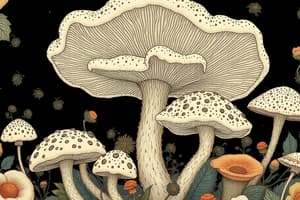Podcast
Questions and Answers
Which Aspergillus species is known to produce aflatoxin?
Which Aspergillus species is known to produce aflatoxin?
- Aspergillus fumigatus
- Aspergillus niger
- Aspergillus flavus (correct)
- Aspergillus clavatus
What is a common cause of systemic infections in patients with weakened immune systems?
What is a common cause of systemic infections in patients with weakened immune systems?
- Pneumocystis jirovecii
- Histoplasma capsulatum
- Cryptococcus neoformans
- Aspergillus fumigatus (correct)
Which of the following fungi is primarily associated with causing pneumonia in individuals with weakened immune systems?
Which of the following fungi is primarily associated with causing pneumonia in individuals with weakened immune systems?
- Aspergillus flavus
- Pneumocystis jirovecii (correct)
- Histoplasma capsulatum
- Cryptococcus neoformans
What symptom is NOT typically associated with Aspergillosis?
What symptom is NOT typically associated with Aspergillosis?
In which area is Histoplasma capsulatum most prevalent?
In which area is Histoplasma capsulatum most prevalent?
Which of the following are functions of fungi in the ecosystem?
Which of the following are functions of fungi in the ecosystem?
What is the main body structure of most fungi called?
What is the main body structure of most fungi called?
Which of the following statements about actinomycetes is incorrect?
Which of the following statements about actinomycetes is incorrect?
How do fungi contribute to the global carbon cycle?
How do fungi contribute to the global carbon cycle?
Which of the following uses of fungi is not correct?
Which of the following uses of fungi is not correct?
Candida species are primarily known for causing infections in which demographic?
Candida species are primarily known for causing infections in which demographic?
What substance can fungi produce as secondary metabolites?
What substance can fungi produce as secondary metabolites?
Which component of the ecosystem do fungi degrade to play a vital role in environmental health?
Which component of the ecosystem do fungi degrade to play a vital role in environmental health?
Flashcards
Aspergillus
Aspergillus
A common type of mold found nearly everywhere. It causes a group of diseases called Aspergillosis.
Aspergillosis
Aspergillosis
A serious form of lung infection caused by Aspergillus. Symptoms include: fever, cough, chest pain, and shortness of breath. It can be life-threatening for people with weakened immune systems.
Cryptococcal meningitis
Cryptococcal meningitis
A fungal infection that can cause meningitis and meningo-encephalitis in people with weakened immune systems.
Histoplasmosis
Histoplasmosis
Signup and view all the flashcards
Pneumocystis jirovecii
Pneumocystis jirovecii
Signup and view all the flashcards
What is Mycology?
What is Mycology?
Signup and view all the flashcards
What are Hyphae?
What are Hyphae?
Signup and view all the flashcards
What is Mycelium?
What is Mycelium?
Signup and view all the flashcards
What are Fruiting Bodies?
What are Fruiting Bodies?
Signup and view all the flashcards
What are Actinomycetes?
What are Actinomycetes?
Signup and view all the flashcards
What are Pathogenic Fungi?
What are Pathogenic Fungi?
Signup and view all the flashcards
What is Candida?
What is Candida?
Signup and view all the flashcards
What are Mycorrhizae?
What are Mycorrhizae?
Signup and view all the flashcards
Study Notes
Mycology
- Mycology is the study of fungi, including yeasts and molds.
- It examines their genetic and biochemical properties.
- It analyzes their taxonomy and human uses (e.g., tinder, medicine, food like beer, wine, cheese, mushrooms, and entheogens).
- It investigates fungal dangers like poisoning and infection.
Fungal Characteristics and Roles
- Many fungi produce toxins, antibiotics, and other secondary metabolites (not essential for survival). Examples include antibiotics and pigments.
- Fungi are crucial for life on Earth as symbionts, like in mycorrhizae, insect symbionts, and lichens.
- Many fungi break down complex organic biomolecules, such as lignin (a wood component), xenobiotics, petroleum, and polycyclic aromatic hydrocarbons.
- This decomposition plays a critical role in the global carbon cycle.
Fungal Impacts and Classifications
- Fungi, and some organisms formerly classified as fungi (oomycetes and slime molds), are important economically and socially, causing diseases in animals (like histoplasmosis) and plants (like elm disease and rice blast).
- Some fungi cause diseases in humans and other organisms.
- The study of pathogenic fungi is termed medical mycology.
- Actinomycetes are a large group of prokaryotic organisms resembling fungi, but are bacteria, with threadlike cells (hyphae) forming branching networks (mycelia).
Fungal Structure
- The main body of most fungi is made up of branching, colorless threads called hyphae.
- Vast numbers of hyphae intertwine to form a tangled web called a mycelium.
- Fruiting bodies (such as mushrooms) are thick hyphae collections.
- Fruiting bodies vary in size from tiny to large and eye-catching structures.
- They are usually produced at the surface of the food source to allow spores to be shed and dispersed by wind, water, or animals.
Pathogenic Fungi Examples
- Candida species are important human pathogens, often causing opportunistic infections in immunocompromised hosts (e.g., transplant patients, AIDS sufferers, cancer patients).
- Candidiasis infections are difficult to treat and can be life-threatening (30-40% mortality rate).
- Aspergillus spores are common in the environment.
- Aspergillus fumigatus and Aspergillus clavatus can cause allergic disease.
- Some Aspergillus species cause disease in grain crops (especially maize), producing mycotoxins like aflatoxin.
- Aspergillosis is a group of diseases caused by Aspergillus. Symptoms include fever, cough, chest pain, and breathlessness. Typically only those with weakened immune systems or other lung conditions are affected.
More Pathogenic Fungi Examples
- Cryptococcus neoformans can cause severe meningitis and meningoencephalitis in HIV-infected and AIDS patients.
- Most Cryptococcus species live in the soil and rarely affect humans.
- Histoplasma capsulatum causes histoplasmosis (mostly lung disease) in humans, dogs, and cats.
- Histoplasma is most prevalent in the Americas, India, and Southeast Asia. Infections are typically from inhaling contaminated air.
- Pneumocystis jirovecii causes pneumonia in people with weakened immune systems (e.g., premature babies, the elderly, and AIDS patients).
Studying That Suits You
Use AI to generate personalized quizzes and flashcards to suit your learning preferences.




